Master Bedroom Suite Size
Master Bedroom Dimensions & Layout Guidelines (with Photos)
Your master bedroom is a source of comfort, that is when the dimensions are perfect. Dimensions vary based on several factors, such as your floor plan and personal taste. Whether it be 110 square feet or 400+ square feet, let's explore the ideal dimensions for a master bedroom.
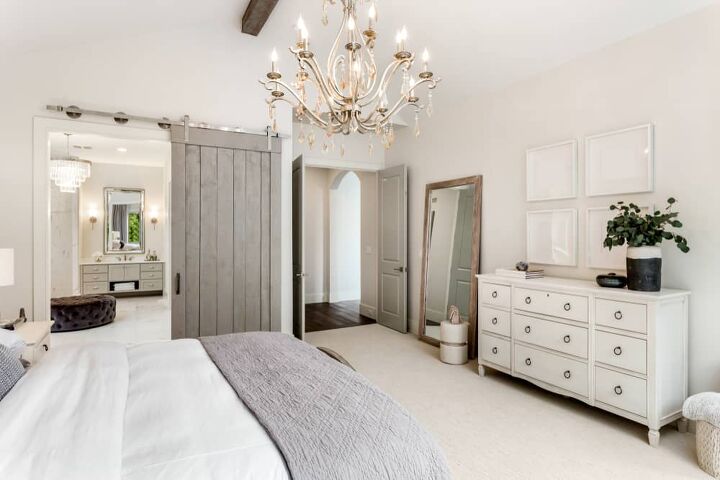
A master bedroom should feel like a retreat, whether cozy, lavish, or ultra-modern. While the room's size dictates a good portion of your design, even the smallest master comes with options.
For a simple master bedroom, sizes can range from roughly 110 to 200 square feet. However, today, most masters include walk-in closets and master bathrooms. These additions make the overall square footage range from about 230 to over 400 square feet.
In smaller homes, a typical master suite averages about 231 square feet. Larger homes have master bedrooms that reach up to 411 square feet, while some can become multi-room showstoppers. The size of your master bedroom ultimately hinges on your home's existing footprint, unless, of course, you plan to build.
Looking to make an addition?
Get free, zero-commitment quotes from pro contractors near you.
FIND LOCAL CONTRACTORS

Table of Contents
- Start with Your Bed
- Different Types of Bed Sizes
- Leave Enough Room Around the Bed
- Dimensions of a Master Bedroom with a Queen Bed
- If You Give a Queen Bed the Green Light
- Dimensions of a Master Bedroom with a King Bed
- Dimensions of a Master Bedroom with a California King Bed
- How Does a Master Walk-In Closet Influence Room Dimensions?
- Extra Considerations When Planning a Master Bedroom Layout
- Tips for Working with a Small Master Bedroom
- Dimensions of a Master Bedroom with a Full Bed
- Related Questions
-
- What exactly is a master suite? Is it the same as a master bedroom?
- What size is a typical master bathroom?
- Related Guides
-
Start with Your Bed
Of course, the main showpiece in any bedroom is the bed. Therefore, when planning your master suite's layout, start with your bed (or the bed you plan to get). Depending on the room's size, you may or may not want to rethink the size of your bed.
For example, if your room is a smaller size, a king bed might make things feel super cramped. On the flip side, if you have a lot of space, a queen bed might look lost in the abyss. First things first, consider the standard dimensions of the different bed sizes.
Different Types of Bed Sizes
| Bed Size | Width | Length |
| Twin/Single | 38" | 75" |
| Twin XL | 38" | 80" |
| Full/Double | 53" | 75" |
| Queen | 60" | 80" |
| King | 76" | 80" |
| California King | 72" | 84" |
This chart lays out the width and length of bed sizes that are pretty much standard across the board. Bed height can vary from bed to bed based on the design and style.
For example, a platform bed generally sits lower than a regular bed. Alternatively, a bed with a lot of included storage can be much taller. When it comes to master bedrooms, the most common beds are a queen, king, or California king bed.
Leave Enough Room Around the Bed
After considering the bed size, the next big factor to think about is the space around your bed. Unless you plan to crawl over the bed from one side to another, you should have at least 30 inches on either side. Plus, you should also leave at least 30 inches of space at the foot of the bed.
This minimum clearance allows you to maneuver around the room with minimum difficulty. But, if you have the room to spare, three feet of space on every side of the bed (including the foot) is ideal for maximum comfort. It also looks better, giving the room an open, airy, and relaxing feel, which is important for a bedroom.
Keep in mind, a master bedroom is typically designed for two people. Therefore, the more room you have to move around, the better. The bigger your master bedroom, the more space you should leave surrounding the bed.
Dimensions of a Master Bedroom with a Queen Bed
If your master bedroom is pressed for space, you might want to opt for a queen bed. Using a queen bed can give the illusion of more room while still being pretty comfy for two people.
Of course, you have to take into account how you and your partner would fit together in a queen bed first. Since queen beds and king beds are the same, your height doesn't play too big a factor. However, you do lose 16 inches of width.
Therefore, if you like to spread out or toss-and-turn, you might need to rethink a queen bed. If you're not comfortable, or it feels awkward, then it's probably not worth the extra 16 inches of space.
If You Give a Queen Bed the Green Light
If you decide you can handle a queen bed in your master bedroom, you need at least 92 sqft. A room that is about 10 x a little over 9 feet, would provide a minimum clearance of 30 inches.

If you want more room around the bed, a roughly 11 x 10-foot area gets you 36 inches around the bed. These measurements do not include a bathroom or closet or any type of nook or extra space. So, these dimensions are the bare minimum for just the livable square footage in your bedroom area.
If you want an additional zone in your bedroom, like a desk or reading corner, you need extra space. Likewise, if you need a closet to fit within the footprint of the overall space, you need more room. With a queen bed, you could fit a desk and closet if your room's around 125 to 135 square feet.

Dimensions of a Master Bedroom with a King Bed
A king bed is perhaps the most common size bed in a master bedroom. This bed offers the most size in terms of width, making it ideal for two people.
To make a king bed work in your bedroom space, you should have at least 106 square feet. This square footage provides enough room for your bed and 30 inches of clearance around the entire piece.
In order to have 36 inches of space around your bed, you'll need about 122 square feet of space. Again, this square footage is for your bed and free space only.
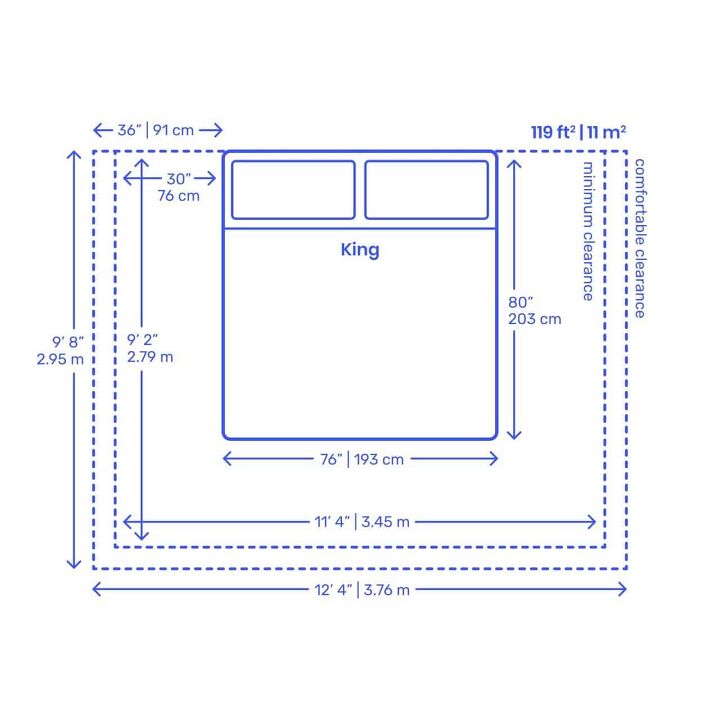
If you want to add in closets and extra items to your bedroom's overall footprint, your square footage must increase. You'll need at least 140 square feet to make it work, closer to 150 sqft to work very comfortably.
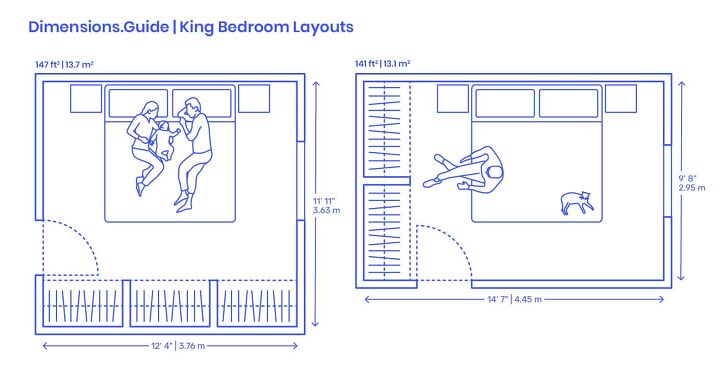
Dimensions of a Master Bedroom with a California King Bed
What's interesting about a California king is you don't need much more space than you would for a king bed. While a California king bed is 4 inches longer than a king bed, it's also 4 inches narrower. 120 square feet can fit your bed comfortably, while even 105 square feet gets you 30 inches of bed clearance.

Therefore, the overall square footage of your room stays somewhat the same, but your layout might look different. Since a California king is longer, you might want to position it to run along the longest length of the room. This way, you can ensure enough space around the foot of the bed.
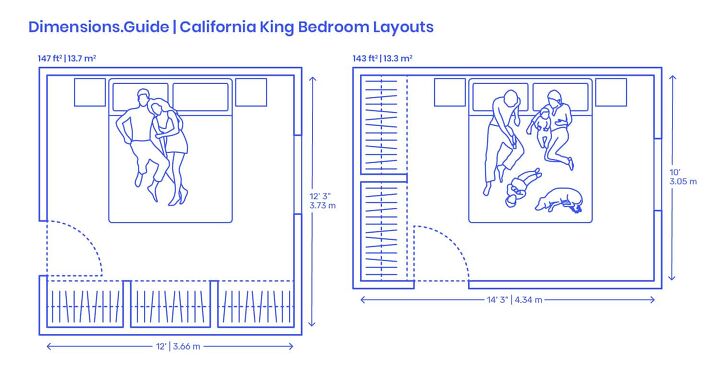
How Does a Master Walk-In Closet Influence Room Dimensions?
The above dimensions and layouts consider reach-in closets in the master bedroom. However, many masters include walk-in closets that can increase the overall footprint of your space. Quite often, a walk-in closet can be two to three times larger than a reach-in.
Although this increases the room's overall square footage, concentrate on the livable area when planning your room layout. The main factors to keep in mind are the clearance around the bed and open pathways throughout the room.
These elements should stay constant, no matter what kind of closet you have in your master bedroom.
When you plan your master bedroom layout, there are a few extra considerations to keep in mind. In addition to the bed size and space around it, think about the flow of the whole room.
It's important to allow adequate space to move from one point to another. This is especially important in a master since there are likely to be two people in the room at the same time.
Think about the walkways between the bed and bathroom, the bed and closet, and so forth. Also, consider the space your closet doors take up when open, and make sure you don't position furniture to close.
Tips for Working with a Small Master Bedroom
In some cases, as much as you want a spacious master bedroom, your available space just won't work. You can cheat your layout and design a few ways to give the illusion of more space.
Using various items like mirrors and mounted lights can help free up space and bounce light around the room. This can add a sense of airiness to the space.
Also, although it is not ideal, you can sacrifice some space around your bed or even push it into a corner if necessary. You can also mount shelves on the wall to act as nightstands. A regular nightstand, on average, is about 15 x 23 inches, so a shelf frees up valuable floor space.
Of course, you can also opt for an even smaller bed.
Dimensions of a Master Bedroom with a Full Bed
While a full or double bed is certainly not the norm in a master, it isn't unheard of. In fact, a full bed could be a good solution for a master if you live alone. It also can work if you simply only have a small room to use as your master.

You only need about 85 square feet of space for a full bed and 30 inches around it. For 36 inches of bed clearance, you need roughly 97 square feet. Once you add closets, plan on needing closer to 115 to 120 square feet.
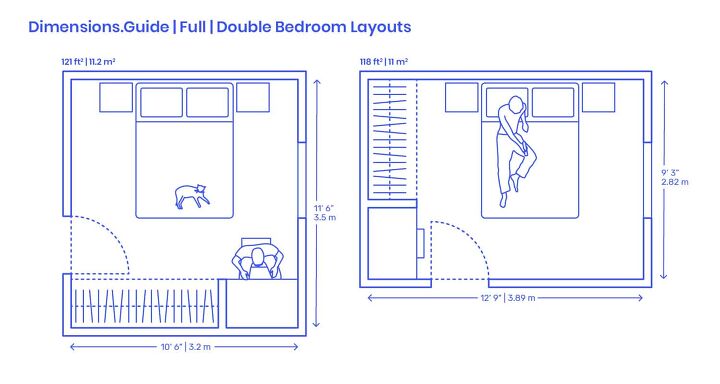
Looking to make an addition?
Get free, zero-commitment quotes from pro contractors near you.
FIND LOCAL CONTRACTORS

What exactly is a master suite? Is it the same as a master bedroom?
A master suite is simply the name of a master bedroom that has a bathroom attached. Typically, for it to be considered a master suite, the bedroom must have direct access to the bathroom.
Master suites can also feature other amenities like a sitting area, reading nook, or extra-large walk-in closets. However, these are not required for the room to be a master suite. Master suites can easily reach sizes that exceed 400 square feet or more.
What size is a typical master bathroom?
Just as master bedrooms are usually larger than regular bedrooms, master bathrooms are typically larger than other bathrooms. Today, master bathrooms usually range from about 115 to 210 square feet, with an average of about 160. This makes many master bathrooms the same size, if not bigger than many master bedrooms!
Master baths are usually larger because they are made to accommodate two people. Therefore, many master bathrooms, or en suites as they are called, feature double sinks and vanities. Many master baths will also feature a separate tub and shower as well as ample storage. Plus, they are normally created to be showstoppers that can really drive up a home's value.
Depending on your preferences and available space, you can create a comfortable master bedroom to be your very own sanctuary. Just remember to work with the space you have and don't try to cram too much into it. Otherwise, you might find yourself facing some restless nights.
- Best Master Suite Floor Plans (With Dimensions)
- Small Master Bedroom Ideas
- Bedroom Layout Ideas (For Rectangular Rooms)
Stacy Randall
Stacy Randall is a wife, mother, and freelance writer from NOLA that has always had a love for DIY projects, home organization, and making spaces beautiful. Together with her husband, she has been spending the last several years lovingly renovating her grandparent's former home, making it their own and learning a lot about life along the way.
Recently Published
Source: https://upgradedhome.com/master-bedroom-dimensions/







Tidak ada komentar:
Posting Komentar